



Web Surfers, WebMasters and Mistresses: Please note:
Before copying this information to use for a course project or assignment or report: Or for use on a web site, PLEASE consider the time that it has taken myself and others. The information documented here is a compliation of many hours of research and developement.
You will find references below and credit is expected where it is due... Thank you...
This is a very large file and it will take a while to load and digest. So, go make a pot of coffee.
Any ??? Please send E-mail,
Thank you in advance... Mitch
The Great Conflagration
On Oct. 9, 1871, the Great Chicago Fire started.
This tragic fire killed about 300 people, left 100,000 homeless and destroyed
more than 17,000 structures.
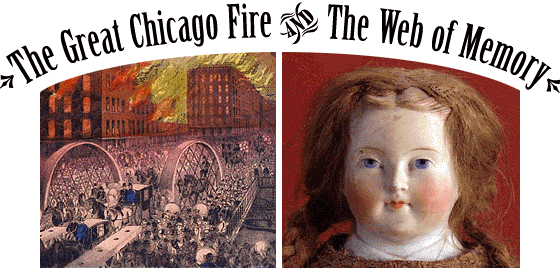
One popular legend claims that Mrs. Catherine
O'Leary was milking her cow when the animal kicked over a lamp, set the
O'Leary's barn on fire and started the fiery conflagration. The city of Chicago
was fast to rebuild and soon began to remember the event with festivities. The
Fire Marshals Association of North America believed the 40th anniversary of the
Great Chicago Fire should be observed in a way that would keep the public aware
of the importance of fire prevention.
On Oct. 9, 1911, FMANA sponsored the first
National Prevention Day. In 1920, President Woodrow Wilson issued the first
national Fire Prevention Day proclamation. By 1925, President Calvin Coolidge
proclaimed the first National Fire Prevention Week, which was Oct. 4-10, 1925.
He noted that in the previous year approximately 15,000 lives had been lost to
fire in the United States. President Coolidge's proclamation stated, "This
waste results from conditions that justify a sense of shame and horror; for the
greater part of it could and ought to be prevented.... It is highly desirable
that every effort be made to reform the conditions that have made possible so
vast a destruction of the national wealth."
National Fire Prevention
Week is always the week in which Oct. 9 falls. Each year, a specific theme is
chosen and is commemorated throughout the United States.
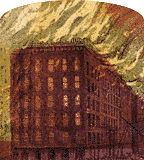
Fire Narrative of Bessie Bradwell Helmer
Besides the fact that the Great Chicago Fire started around 9 o'clock on Sunday evening, October 8, 1871, somewhere in or very near the O'Leary barn, the exact particulars of its origins are unknown. But, given the dry summer and the careless way the city had been built and managed, a kick from a cow would have been sufficient but by no means necessary to burn Chicago down. As A.T. Andreas, the city's leading nineteenth-century historian, put it, "Nature had withheld her accustomed measure of prevention, and man had added to the peril by recklessness."
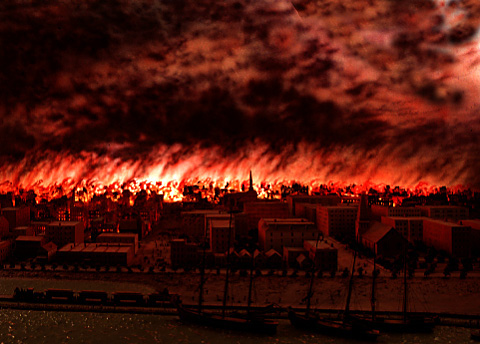
Chicago averaged about two fires a day the previous year, including twenty in the preceding week. The largest of these occurred just on Saturday night. Firemen still might have been able to contain the Sunday blaze but for a series of technological and human failures in the alarm system. The fire, driven by a strong wind out of the southwest, headed straight for the center of the city. It divided unpredictably into separate parts by hurling out flaming brands on the superheated draft it generated, leaping the South Branch of the Chicago River around midnight. Dividing yet again, it made short work of Conley's Patch. By 1:30 it reached the Courthouse tower, from which the watchman barely escaped through the burning stairway by sliding down the banisters. When city officials realized that the building was itself doomed, they released the prisoners from the basement just before the great bell plummeted through the collapsing tower.
Burning of the Crosby Opera HouseAs thousands fled to the North Division, the fire pursued them. By 3 a.m., it had consumed the Rumsey homes on Huron Street, and a half-hour later the roof collapsed on the pumping station, effectively rendering any firefighting efforts useless. Back in the South Division, the luxurious new Palmer House gave way, along with the offices of the Chicago Tribune, whose editors throughout the summer and fall had exhorted the Common Council to raise the level of fire protection if they wished to avoid just this sort of disaster. One of the last South Division structures to fall was Terrace Row. By noon on Monday the North Division fires had reached North Avenue. They advanced the better part of a mile to Fullerton Avenue, then the northern limit of the city. Tuesday morning a saving rain began to fall, and the flames finally died out, leaving Chicago a smoking, steaming ruin.
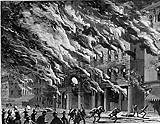
As the fire spread out of control, the mood of the population shifted from interest and concern to alarm and panic. Many heard the Courthouse bell and saw the red and amber flames in the distance but thought little of what was by this time a commonplace occurrence. Individuals who worked in downtown buildings that were supposed to be "fireproof," like the one that housed the Tribune, or simply people understandably fascinated with the spectacle, rushed to positions from which they could watch its progress. Before long, however, they realized that there was no place of guaranteed safety. Fascinated as well as fearful, people alternately--even simultaneously--tried to get the best view and flee for their lives with what little--which was often nothing--they could salvage, creating havoc in the streets and wild crowding on the bridges crossing the river. Husbands and wives, parents and children, were separated. It seemed as if the ground was itself on fire--which in fact it was, since the streets, sidewalks, and bridges were made of wood. Even the river seemed vulnerable, as several vessels and grease along the water's surface ignited. Later there were reports of Chicagoans trapped or crushed in their homes, on one of the bridges, or in the Washington and LaSalle Street tunnels, the latter of which had just opened in early July. Along with the stories of narrow escapes, heroic rescues, and selfless mutual assistance, there were also tales--no doubt exaggerated but with some basis in fact--of looting and drunkenness, as well as of outrageous demands and outright thievery by those with wagons who had been hired to cart goods to safety. "'Pay as you go' had become the watchword of the hour," observed one of the refugees drily. "Never was there a community so hastily and completely emancipated from the evils of the credit system."
The burned-out gathered in dazed and dispirited groups on open stretches of prairie west and northwest of the central city, in the South Division along Lake Michigan, in the North Division at the south end of Lincoln Park, and along "the Sands," a patch of lakeshore just north of the river. Here Chicagoans who heretofore had little contact with each other were unceremoniously forced together. As a fire history put it, one could find "Mr. McCormick, the millionaire of the reaper trade, and other north-side nabobs, herding promiscuously with the humblest laborer, the lowest vagabond, and the meanest harlot. Once they settled themselves, there was little they could do but bear witness to this calamity beyond comprehension.
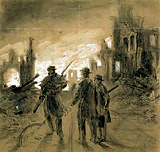
This city never was, and probably never will be again, so thoroughly guarded and watched with so many anxious eyes, as it was on that fearful Monday and the few succeeding days.
Narrative of Charles C.P. HoldenEmergency Measures General Sheridan in Command.
The Relief and
Aid Society Takes Over Official Actions Military Rule in Chicago Organizing the
Relief
Mayor Roswell B. Mason reached his office in the Courthouse about midnight, and for the next two hours he followed the fire's progress, issued commands, and sent telegrams to other cities beseeching them for additional men and equipment. Forced to flee the burning building, he was now only one more frightened fugitive in the crowded streets, with no alternative other than to try to make it back to his nearby South Division home--if it was still standing. As it turned out, his house was spared, though the advancing flames forced him to take a long detour into the North Division before heading back. Almost three hours later he completed his nightmare journey.
On Monday morning, with the city still ablaze, Common Council President Charles C.P. Holden called a combination of elected officials and prominent citizens to a meeting later in the day at the First Congregational Church, out of harm's way in the West Division. They turned the church into a temporary city hall--the first of several makeshift provisions for government services--and arranged to enlist citizens as special deputies, as well as to provide food and water to the burnt-out. Mayor Mason joined the meeting by mid-afternoon, in time to sign a proclamation pledging "the faith and credit of the city of Chicago" to "the preservation of order,...the relief of suffering," and "the protection of property." Other executive orders established the price of bread, banned smoking, limited the hours of saloons, and forbade wagon drivers from charging more than their normal rates.
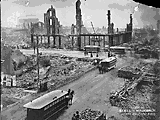
This group also established a Relief Committee, consisting of private citizens and elected officials from the three divisions, whose task it was to organize and administer the distribution of food, supplies, and money that, thanks to the telegraphed reports of Chicago's distress, began arriving that evening. Contributions eventually totaling about five million dollars in value came from towns and cities across the country and the world, from schoolchildren, labor organizations, and civic associations.
Given the appalling circumstances, the Common Council's actions seem admirably clear-headed and effective. But to those who felt that the dying out of the flames hardly meant the end of danger, they were not enough. In the wake of the stories of looting, drinking, and arson came reports that professional thieves from elsewhere and local low-life were now eager to take advantage of weakened Chicago. "The city is infested with a horde of thieves, burglars, and cut-throats, bent on plunder, and who will not hesitate to burn, pillage, and even murder, as opportunity may seem to offer to them to do so with safety," warned the Chicago Evening Journal a day after the fire. The national press carried similar stories, which also appeared in personal accounts. Cassius Milton Wicker, a freight agent for the Chicago and Northwestern railroad, wrote to his family in Vermont, "With the close of the fire, or rather conflagration, our troubles have not closed. Roughs and thieves from all parts of the country flocked here for plunder."
Lt.-General P.H. Sheridan
These kinds of paranoid tales inevitably follow any large-scale cataclysm, and how much truth was behind them is one of the many things about the fire that is impossible to ascertain. Virtually all such anecdotes were not based on personal observation but on hearsay, and it is likely that people like Wicker got their information from reading the papers. But there is no question that the fears which generated and sustained the rumors were real, especially for some middle and upper class native-born Chicagoans. In their eyes, what was immediately required was the assertion of authority. At the same time, however, they had little trust in local government, particularly the members of the Common Council. Such fears and distrust were prompted by notorious events that preceded Chicago's tragedy and influenced how people understood it. The fire was all too reminiscent of the Paris Commune, which had been put down in late May of 1871 in a bloody battle that ended with Paris set afire by radicals in a last-ditch act of defiance against the Versailles government. Closer to home, the exposure of New York's Boss Tweed bolstered suspicion of urban political organizations.
In this context Mayor Mason followed the urging of the city's social and economic elite in taking two extraordinary steps to assure the rescue and relief of Chicago. The first was to entrust the "preservation of the good order and peace of the city" to Lieutenant-General Philip Sheridan, the Civil War hero and Indian fighter who now lived in Chicago and who commanded the Division of the Missouri from his South Division office. Two days later, on October 13, Mason turned over the administration of the relief to the Chicago Relief and Aid Society, which had appealed to him to take this step. On the Society's board sat some of the Old Settlers who had established the organization two decades earlier, but its driving spirit was a younger group of businessmen and professionals that included merchant Marshall Field, sleeping car manufacturer George Pullman, and attorney Wirt Dexter. These men had a very substantial stake in the city's future and an equally firm belief that this future depended on reestablishing a defined social order that had been severely disrupted in the social chaos of the fire.
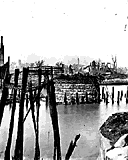
For two weeks Sheridan oversaw a de facto martial law of dubious legitimacy enforced by a mix of regular troops, militia units, police, and a specially organized "First Regiment of Chicago Volunteers." They patrolled the streets, guarded the relief warehouses, and enforced curfews and other regulations. John DeKoven, cashier of the Merchants' National Bank of Chicago, wrote to his wife of his experience as a sentry, "I have not had my clothes off for a week, the city is paroled [sic] every night, you should have seen me last night paroling our alley with a loaded revolver in my hand looking for incendiaries for there are many about." For several months after conventional law and order had been restored, state politicians disputed whether such measures were justified and legal, but their immediate calming effect was evident. Former Lieutenant-Governor William Bross, part owner of the Tribune and refugee from Terrace Row, later recollected his response to the arrival of the soldiers Sheridan summoned from Omaha and Leavenworth: "Never did deeper emotions of joy overcome me. Thank God, those most dear to me and the city as well are safe."
The Relief and Aid Society's fire activities were considerably more long-lived, extending into 1874. Dividing the city into districts, the Society opened offices and supply depots connected by telegraph and separated its work into different areas--contributions, shelter, employment, transportation, distribution, and health--each overseen by a different committee. It not only distributed food and clothing, but also made available the materials for several thousand simple "shelter houses," erected four barracks for the homeless poor, helped secure necessary tools and appliances to those who required them, and performed some 64,000 vaccinations against smallpox. It was a model of a new kind of "scientific" charity whose work was conducted by paid professionals carrying out the policies of an executive board.
The BarracksThese policies reflected the board members' particular social vision. Concerned about losing the city's labor force, they soon suspended the issuing of free railroad passes to fire refugees. Similarly, they took better care of certain members of the population than others. The shelter houses were reserved mainly for skilled workers. The Committee on Special Relief looked to the needs of those more genteel fire victims who "were borne in a single night from homes of comfort and plenty into absolute destitution." It was assumed that such people of refinement would have to be found and helped discreetly, since they would be too proud to ask for help.
As for the able-bodied poor, the barracks were good enough--probably better, the Society maintained, than the housing they had lost. The best thing was to get them off relief and back to work as soon as possible. The Society took great care "to detect and defeat imposition" on its charity by such people and "to aid in establishing order by withholding encouragement to idleness," which was a threat to social order. It was determined to "give no aid to any families who are capable of earning their own support," at the same time assuring the productive labor necessary to rebuild the city. It required applicants to fill out various forms if they wanted aid and to supply a reliable reference, such as an employer or minister. Then a "visitor" would check personally on the merits of the case. A labor exchange was set up with the philosophy that "Any man, single woman, or boy, able to work, and unemployed at this time, is so from choice and not from necessity."
The Relief and Aid Society deserves a great deal of credit for its extraordinary efforts. It probably did dispense the world's charity more effectively than Chicago's overburdened and underfinanced post-fire city government could have done. But its supporters' assessment of the dangers of entrusting the funds to local officials, like many other rumors connected with the fire, were exaggerated by concerns about the balance of power in a democracy defined by class and ethnicity (the Society took care to identify its clients by national origin). Journalist Sydney Howard Gay, who later wrote the Society's self-congratulatory report, claimed that its leaders were men "above personal temptation" who saved the relief from "the utter corruption of our city politics." The alternative, the Tribune agreed, was "the foul brood of city politicians who greedily "counted...upon retaining place and putting their enemies under their feet, with the personal and pecuniary power which the handling of the relief fund and provisions in kind would give them."
Meanwhile, some applicants grumbled about inefficiency, impersonality, and favoritism. In late February the Society terminated assistance to 800 families on the grounds that they were now the responsibility of the financially-strapped county government, drawing severe criticism for withholding aid to the needy in the dead of winter when the organization possessed the only resources available. Common Council President Holden proposed that the Society be made to hand over the remaining relief funds to the city. But the proposal failed, and the consensus remained that the Society, like Sheridan and his soldiers, had saved Chicago in its hour of need when its own worst enemy was perhaps itself. "In the midst of the most pressing demands of their private affairs," Frederick Law Olmsted told readers of The Nation, "men of great good sense and well informed have taken time to devise and bring others into a comprehensive and sufficient organization, acting under well-guarded laws."
QUEEN OF THE WEST ONCE MOREThe capitalists, the mercantile and business interests of this country and of Europe cannot afford to withhold the means to rebuild Chicago.... What she has been in the past she must become in the future, and a hundred fold more.
William Bross, Speech to the New York Chamber of Commerce
Back in Business Bricks and Mortar Body and Soul
The New City
Our Trade and Commerce Political Economy of the Fire
Burnt out of his home on Terrace Row, William Bross expended little energy on self-pity. Chicago's future was at risk, and there was no time to lose. The fire ended Tuesday at dawn, and by Thursday evening he was on a train to New York. On his arrival he spoke to reporters eager for eyewitness reports, and soon after he addressed local businessmen. His point was simple and direct: the fire opened rather than foreclosed opportunities to invest in his city. New York, "the senior partner" in American enterprise to "junior partner" Chicago, couldn't "sit by and see the business of the firm crushed out when he has the means to establish it on a scale more gigantic and more profitable than ever before." John Stephen Wright, the king of Chicago boosters, who had ceaselessly promoted the city's prospects over the previous four decades, even more boldly declared, "Five years will give Chicago more men, more money, more business, than she would have had without this fire." He followed this with the colorful observation, "Chicago is not burnt up, only well blistered for bad ailments, to strengthen her for manhood."
This talk of Chicago as a junior partner approaching manhood emphasized that the fire had done nothing to damage the city's most important quality, its remarkable potential for continued growth. And, whether they were speaking more from concern or from confidence, both Bross and Wright prophesied true. Industrializing America had too much invested in Chicago's development, and the features that made that development possible-- the city's location and resources--were still in place. After a brief downturn in the financial markets and an even briefer moment of doubt about the future on the part of some Chicagoans, the city's rebuilding began in earnest. Within days a few pioneer businesses sprang up in sheds and stands among the ruins, and traffic started moving again. The rubble was swept away, a good portion of it pushed into the lake south of the river to make new real estate. Basic services were quickly reestablished in temporary quarters--the post office, for example, was set up in the Methodist Church on the corner of Wabash and Harrison. Inside of six weeks, work had begun on 212 stone and brick buildings in the South Division alone.
Bird's-Eye View of the Business DistrictVisitors soon looked upon a new Chicago that a local journalist described as "better classified, and its future more distinctly marked, than could have been possible before the fire." The flames had spurred changes already in progress in the pre-fire city by clearing the way for the doubling of the size of the downtown and the construction of taller buildings in this area, as well as a more distinct division of location of businesses by type. Commercial and residential districts likewise became more sharply separated from each other, as Chicagoans of all income levels moved further from the central city and into neighborhoods which were in turn more clearly distinguished from one another than they had been previously.
What was called the "Great Rebuilding" involved more than physical reconstruction. Mayor Mason set Sunday, October 29, "as a special day of humiliation and prayer; of humiliation for those past offenses against Almighty God, to which these severe afflictions were doubtless intended to lead our minds; of prayer for the relief and comfort of the suffering thousands in our midst; for the restoration of our material prosperity, especially for our lasting improvement as a people in reverence and obedience to God." At the same time such occasions tended to the soul of the city, others focused on its political well-being. In the November mayoral election, Chicagoans voted in Tribune co-owner Joseph Medill on a Union Fire Proof ticket pledged to stricter building codes.
The Union Fire Proof TicketBut Chicago's resurrection was a good deal bumpier than the booster vision admitted. Among more prosperous citizens, the fire rearranged many lives, wiping out one person's home and assets while creating new possibilities for others. The situation for the less well-off was on the whole more difficult. In mid-January of 1872 an angry group of demonstrators carrying placards with such slogans as "Leave a Home for the Laborer" and "Don't Vote Any More for the Poor Man's Oppressor" broke up a meeting of the Common Council. They were protesting proposed restrictions on flammable building materials as discriminating against those who could only afford wood. Working people were caught in other binds, as landlords and employers saw no contradiction in their charging higher rents because of the housing shortage as they appealed to laborers to hold the line on wages. Workers who attempted to organize--there was a failed strike by carpenters and a successful one by bricklayers in the fall of 1872--found themselves deemed enemies of the common good in the newspapers. The influx of newcomers seeking employment in rebuilding Chicago worsened the situation for workers by keeping down the price of labor while raising rents.
There were other hardships and conflicts. The rapid pace of rebuilding, assisted by the innovative use of derricks, led to an extraordinary number of injuries and deaths on the job. To add insult to such injuries, a group of native-born reformers, ever fearful of social disorder, focused on alcohol as the root of all evil. They forced Mayor Medill to enforce an existing ban on Sunday drinking, which Chicagoans of Irish and German extraction correctly took as an attack on the saloons and beer halls in which they socialized. As Chicago politics became more markedly class-driven, Medill resigned his office and left for Paris. In the fall of 1873, Harvey Colvin, the native-born standard-bearer of a new coalition of ethnic voters that called itself the People's Party, was elected over the "reform" candidate.
The Inter-State ExpositionThe period of the Great Rebuilding came to a close with the Panic of 1873, which proved to be a more serious deterrent to the local economy than the fire. By December of that year the unemployed were chanting "Bread or death" outside the offices of the Relief and Aid Society, which once again refused to accede to demands to turn the balance of its funds over to the city. Not long after, in July of 1874, another fire struck the city. It started in the 400 block of South Clark Street and advanced in the same northeasterly direction as the 1871 conflagration, to Michigan Avenue and Van Buren Street, destroying about fifty acres and over eight hundred buildings. Following this disaster a threatened boycott by insurers compelled the city to adopt stricter safety rules and improve the fire department.
Some commentators who tried to take a broader view of the Great Fire and the Great Rebuilding expressed concern that the losses were profounder and less easily calculated than at first appeared. Impatient even before the fire with the slow development of refinement in the "junior partner," they were discouraged by the prospect that the need to rebuild would only delay this process further. Most of the population had little time for such reflections. The population topped 500,000 by 1880, more than a million a decade later. By the late spring of 1873, the city was ready to celebrate its recovery, hosting a jubilee week in June. In the same year its business leaders, including several who served on the board of the Relief and Aid Society, hosted the Inter-State Industrial Exposition in a grand building on the lakefront. Chicago, as an inspirational post-fire song went, was "Queen of the West once more."
The Inter-State ExpositionThe period of the Great Rebuilding came to a close with the Panic of 1873, which proved to be a more serious deterrent to the local economy than the fire. By December of that year the unemployed were chanting "Bread or death" outside the offices of the Relief and Aid Society, which once again refused to accede to demands to turn the balance of its funds over to the city. Not long after, in July of 1874, another fire struck the city. It started in the 400 block of South Clark Street and advanced in the same northeasterly direction as the 1871 conflagration, to Michigan Avenue and Van Buren Street, destroying about fifty acres and over eight hundred buildings. Following this disaster a threatened boycott by insurers compelled the city to adopt stricter safety rules and improve the fire department.
Some commentators who tried to take a broader view of the Great Fire and the Great Rebuilding expressed concern that the losses were profounder and less easily calculated than at first appeared. Impatient even before the fire with the slow development of refinement in the "junior partner," they were discouraged by the prospect that the need to rebuild would only delay this process further. Most of the population had little time for such reflections. The population topped 500,000 by 1880, more than a million a decade later. By the late spring of 1873, the city was ready to celebrate its recovery, hosting a jubilee week in June. In the same year its business leaders, including several who served on the board of the Relief and Aid Society, hosted the Inter-State Industrial Exposition in a grand building on the lakefront. Chicago, as an inspirational post-fire song went, was "Queen of the West once more."
For more information, plz go here: Fire Prevention Week
Also: Info on Fire related statistics can be found
here at
The
Centers Of Disease Control and Prevention
Also: please check out The American Burn Association
Info obtained from the NET at The Pheonix Fire Dept's Official WebSite
and: Chicago HistoryThis public service information was brought to you by:
The finest Paramedics in the world and on the W.W.W. from America's Finest City...
http://www.publicsafety.net/sdpar.htm
Brief Disclaimer.
 The Beginning |
 Navigation |
S.D. Dispatch |
S.D. Paramedics |
S.D. MedNews On-Line |
E.K.G. |
 LINKS |
Public Safety |
Magic Wand |